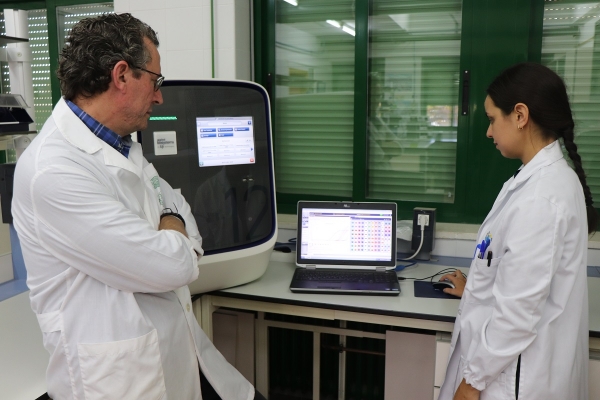Discovering them merited their discoverers a Nobel Prize in the 1990s. MicroRNAs are small RNA molecules that do not code for proteins, however, they take care of an essential function: they act as regulators in gene expression, and so they have become a focus of attention for medical science. Despite there being thousands of different sequences of this genetic material, the individual role that each one plays in several illnesses continues to be unknown for the most part.
Recently, research done at the University of Cordoba, among other places, and published in Nature Microbiology, was able to determine the specific function of certain microRNAs in Salmonella Typhimurium and Shigella flexneri infections. These are two similar bacteria that are passed on to humans upon ingesting food or water infected by people or animals with the disease.
These are two intracellular pathogens that invade healthy cells and cause similar symptoms. Nevertheless, in spite of their many similarities, the results show that infections from these two bacteria are controlled by different microRNAs that have a radically opposite function.
In order to come to this conclusion, an array of over 1,400 different microRNAs were studied individually so as to verify what effect they produce in cells upon being infected by these two bacteria, explains University of Cordoba Genetics Department researcher Sara Zaldívar.
In the case of Shigella, the results show that upon infection, three specific kinds of microRNA silence the expression of the gene responsible for spreading the bacteria within the infected organism by means of filaments called filopodia. This is an immune response mechanism of the infected organism that, as a result, lessens the bacteria’s movement.
In the case of Salmonella, almost the opposite occurs. Once the cell is infected, a kind of microRNA activates the expression of a gene responsible for the bacteria reproducing. This is the pathogen’s attack mechanism in order to reproduce, something that was not only demonstrated in the laboratory but also was corroborated in vivo in pig intestinal mucosa.
Implications and consequences
The results show two mechanisms of how microRNAs act in completely different ways and that were not described ever before. While in some infections, such as Shigella, these small molecules of genetic material perform a function in the immune response of the infected organism, in others, like Salmonella, they are part of the strategies developed by the bacterium to benefit itself in order to reproduce.
One of the main takeaways from the research, as pointed out by another author, Professor Juan José Garrido, is the need to understand the specific response mechanisms of each pathogen so as to not err by extrapolating treatment. “If we do not know exactly how microRNA regulation works, then we are blindly assigning treatment and we will end up haphazardly using a wide range of antibiotics that build up resistance to the bacteria”, says the researcher. “In our laboratory alone”, adds Sara Zaldívar, “we have strains of Salmonella that have built up resistance to 14 different antibiotics”. For this reason, knowing about the mechanisms of each pathogen in particular is key to developing more effective drugs by means of searching for target genes involved in the process.
The study, whose lead author is University of Cordoba alumni and researcher Carmen Aguilar, used a combination of large-scale cell transfection, gene interference and functional genomics techniques. Involved in the research were the Genomics and Animal Health research group at the University of Cordoba (Spain), the University of Würzburg (Germany), the Pasteur Institute (France), University of Coimbra (Portugal) and King´s Collegue London (the UK).
References
Functional screenings reveal different requirements for host microRNAs in Salmonella and Shigella infection. Autores: Carmen Aguilar, Ana Rita Cruz, Inés Rodrigues Lopes, Claire Maudet, Ushasree Sunkavalli, Ricardo Jorge Silva, Malvika Sharan, Clivia Lisowski, Sara Zaldívar-López, Juan José Garrido, Mauro Giacca, Miguel Mano, Ana Eulalio. NatureMicrobiology. Published: 2019 Dec 2. doi: 10.1038/s41564-019-0614-3


